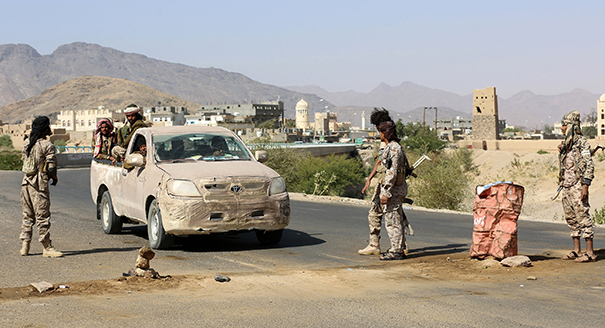The humanitarian catastrophe afflicting Yemen over the past five years has been exacerbated by the country’s suffocating isolation from the outside world. The Saudi-led Arab coalition has blockaded most of the country’s air and sea ports. Meanwhile, fighting has further isolated Yemen’s regions from each other. The expansion of the conflict zone and the competing local parties’ control over different areas have contributed to the rise of internal borders that have systematically kept inhabitants apart.
One example of such dynamics is the growing difficulty to cross from the northern part of Ta‘iz, which is controlled by Ansarullah, more commonly known as the Houthi movement, to the city center, which is held by parties loyal to the internationally recognized government. Even though the distance between the two areas is just a few kilometers, the journey can feel like crossing an international border. Travelers are forced to use alternative rugged routes that result in journeys that can often last hours.
A similar situation exists on the routes that connect Yemen’s northern cities, controlled by the Houthis. Dozens of military checkpoints have been set up to screen travelers and search their belongings. Armed men usually demand documents issued by the travelers’ sponsors in places where they are visiting, or by the authorities the travelers intend to see. The aim it to prevent the entry of anyone who may potentially belong to the opposing camp. Whoever does not meet the criteria risks being detained.
Residents of western and northern areas of Yemen are also finding it increasingly difficult to enter Aden in the south. The forces of the Southern Transitional Council, which controls the city and surrounding towns, have restricted the flow of people into the areas under their control. There is a exception to this, however, in that those traveling through Aden airport can enter into the city, provided that they hold a valid airline ticket and pledge not to remain in Aden.
In central and northern Yemen, both Houthi and loyalist forces have carved out internal borders by setting up checkpoints at the edges of the areas they control. The most prominent of these are the Houthi-controlled checkpoint in the Rada‘a area of Bayda Governorate and the government-controlled Falaj checkpoint in Marib. Both checkpoints, again, restrict the movement of people and goods.

Regional actors have also exacerbated Yemen’s geographical segregation. In early 2018, the United Arab Emirates pressured the then-governor of Socotra into barring the entry of all Yemenis except those originally from the archipelago. This pushed the local authorities to place other restrictions on non-residents, such as demanding that they be sponsored by locals when wanting to visit. They also have limited the use of boats by travelers to the island, to prevent large numbers of displaced from reaching Socotra. In that way they have made air travel the primary mode of transportation to the archipelago. These measures remain in place despite differences between the UAE and the local authorities in Socotra.
Warring parties instituted these new internal borders as a temporary measure to establish their control. However, these have developed into more enduring tools to divide Yemenis and limit movement, creating a new reality of geographically isolated pockets of land. There is an economic rationale for keeping the situation as is. As the conflict drags on and the war economy becomes more anchored, these new borders have taken on valuable economic roles. For example, the Houthis have created a customs center near the capital, San‘a, in the city of Dhamar. This center has imposed high tariffs on goods arriving from areas beyond the Houthis’ control, which represents a valuable source of revenue helping to finance the militia.
Similarly, just as smuggling is common across international borders, so too has it developed along Yemen’s internal borders. To facilitate their smuggling efforts, some networks have coordinated with the militias at checkpoints and paid them off with part of their revenues from smuggling operations. This too has helped harden the militias’ desire to maintain the status quo. These smuggling networks have also become widespread along Yemen’s extensive land and sea borders and have turned to transferring goods such as weapons and drugs.
Yemen’s internal borders have impacted heavily on the lives of civilians. Other than restricting their freedom of movement, such borders have nurtured regionalism and rallied society behind local identities, a phenomenon that will have both short- and long-term effects. Economically, these internal borders have limited work opportunities and raised the cost of basic goods, deepening the suffering of ordinary Yemenis. People were hard hit hard by the recognized government’s decision to move the Central Bank to Aden in 2016, which damaged the banking sector in San‘a, and the Houthis’ more recent decision to stop using the newly-printed riyal.
The presence of internal borders has added an extra layer to Yemen’s many challenges, which include managing its international borders and dealing with a battle for domination among regional states. Yet internal borders are no less relevant. Understanding them allows for a better grasp of Yemen and its conflict.







